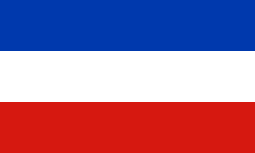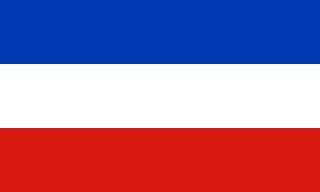
Schleswig-Holstein is the northernmost of the 16 states of Germany, comprising most of the historical Duchy of Holstein and the southern part of the former Duchy of Schleswig. Its capital city is Kiel; other notable cities are Lübeck and Flensburg.

Westphalia is a region of northwestern Germany and one of the three historic parts of the state of North Rhine-Westphalia. It has an area of 20,210 square kilometres (7,800 sq mi) and 7.9 million inhabitants.
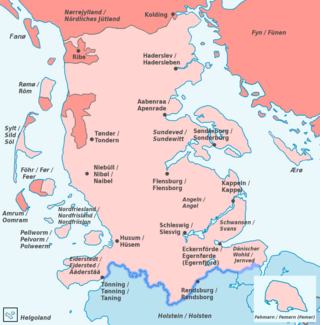
The Duchy of Schleswig was a duchy in Southern Jutland covering the area between about 60 km north and 70 km (45 mi) south of the current border between Germany and Denmark. The territory has been divided between the two countries since 1920, with Northern Schleswig in Denmark and Southern Schleswig in Germany. The region is also called Sleswick in English.

The national flag of Germany is a tricolour consisting of three equal horizontal bands displaying the national colours of Germany: black, red, and gold. The flag was first sighted in 1848 in the German Confederation. It was officially adopted as the national flag of the German Reich from 1919 to 1933, and has been in use since its reintroduction in Federal Republic of Germany in 1949.

Herzogtum Lauenburg is the southernmost Kreis, or district, officially called Kreis Herzogtum Lauenburg, of Schleswig-Holstein, Germany. It is bordered by the district of Stormarn, the city of Lübeck, the state of Mecklenburg-Vorpommern, the state of Lower Saxony, and the city state of Hamburg. The district of Herzogtum Lauenburg is named after the former Duchy of Saxe-Lauenburg.

South Jutland County is a former county on the south-central portion of the Jutland Peninsula in southern Denmark.

The Province of Hesse-Nassau was a province of the Kingdom of Prussia from 1868 to 1918, then a province of the Free State of Prussia until 1944.
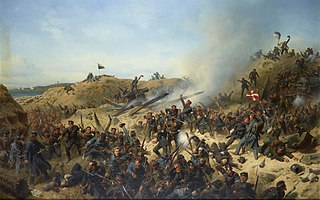
The Second Schleswig War, also sometimes known as the Dano-Prussian War or Prusso-Danish War, was the second military conflict over the Schleswig-Holstein Question of the nineteenth century. The war began on 1 February 1864, when Prussian and Austrian forces crossed the border into the Danish fief Schleswig. Denmark fought troops of the Kingdom of Prussia and the Austrian Empire representing the German Confederation.
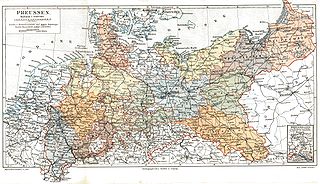
The Provinces of Prussia were the main administrative divisions of Prussia from 1815 to 1946. Prussia's province system was introduced in the Stein-Hardenberg Reforms in 1815, and were mostly organized from duchies and historical regions. Provinces were divided into several Regierungsbezirke, sub-divided into Kreise (districts), and then into Gemeinden (townships) at the lowest level. Provinces constituted the highest level of administration in the Kingdom of Prussia and Free State of Prussia until 1933, when Nazi Germany established de facto direct rule over provincial politics, and were formally abolished in 1946 following World War II. The Prussian provinces became the basis for many federal states of Germany, and the states of Brandenburg, Lower Saxony, and Schleswig-Holstein are direct successors of provinces.
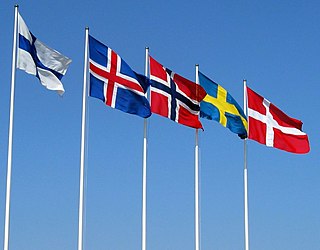
A Nordic cross flag is a flag bearing the design of the Nordic or Scandinavian cross, a cross symbol in a rectangular field, with the centre of the cross shifted towards the hoist.

The Province of Schleswig-Holstein was a province of the Kingdom of Prussia and the Free State of Prussia.

The coat of arms of Schleswig or Southern Jutland depicts two blue lions in a golden shield. It is the heraldic symbol of the former Duchy of Schleswig, originally a Danish province but later disputed between Danes and Germans. The region has been divided between Germany and Denmark since 1920 and the symbol consequently appears in official heraldry in both countries. It is derived from the national coat of arms of Denmark and has been dated to the middle of the 13th century, first known from the arms of Erik Abelsøn, Duke of Schleswig. Throughout the ages, the design has featured both crowned and uncrowned lions, the lions have occasionally been accompanied by heraldic hearts, and usage between heraldic lions and leopards has shifted. The far most common version was to omit both crowns and hearts and this version has been used exclusively for several centuries.
The state of Prussia developed from the State of the Teutonic Order. The original flag of the Teutonic Knights had been a black cross on a white flag. Emperor Frederick II in 1229 granted them the right to use the black Eagle of the Holy Roman Empire. This "Prussian Eagle" remained the coats of arms of the successive Prussian states until 1947.
This is a list of coats of arms of Germany.

The coat of arms of the German federal-state of Lower Saxony shows a white Saxon Steed on a red background.

The coat of arms of North Rhine-Westphalia is the official coat of arms of the German state of North Rhine-Westphalia.
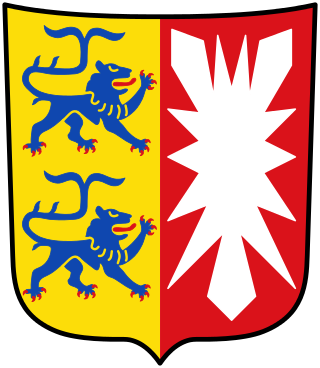
The coat of arms of the German state of Schleswig-Holstein is vertically divided: in the heraldically right field, i.e. left as seen by the viewer, two blue lions are depicted on a golden background, facing the other half. The lions of Schleswig were taken from the coat of arms of Denmark. The heraldically left side is red with the silver nettle leaf of Holstein, an ancient symbol which had been in use with the Counts of Schauenburg and Holstein.

The Saxon Steed is a heraldic motif associated with the German provinces of Lower Saxony and Westphalia, and the Dutch region of Twente.

The flag of Yugoslavia was the official flag of the Yugoslav state from 1918 to 1992. The flag's design and symbolism are derived from the Pan-Slavic movement, which ultimately led to the unification of the South Slavs and the creation of a united south-Slavic state in 1918.
This is a survey of the postage stamps and postal history of Holstein, Schleswig-Holstein, Schleswig and incidentally Lauenberg. Separate stamps were issued for Holstein (1850), Schleswig (1864-1867), Holstein (1864-1866), Schleswig-Holstein (1865) and Schleswig (1920).
